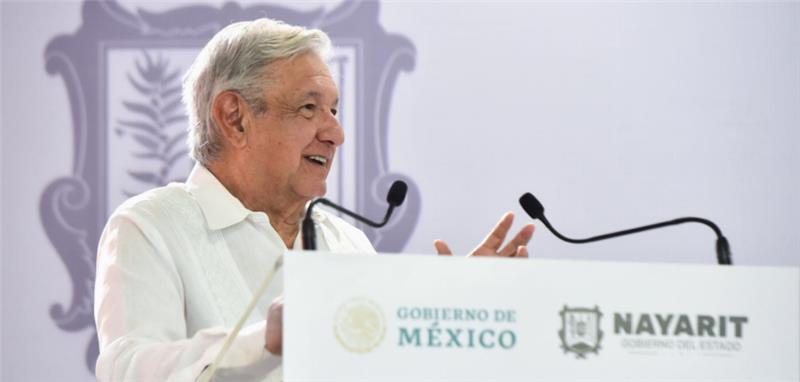Mexico: How Far Have its Institutions Really Come?
The question remains if Mexico has achieved a degree of institutional development consistent with its participation in those organizations.
A Daily Publication of The Dialogue
The government of Mexican President Andrés Manuel López Obrador on Sept. 8 presented its 2022 budget, which Finance Minister Rogelio Ramírez de la O previously described as “balanced between income and spending” as well as “responsible and realistic.” What does the new budget say about López Obrador’s priorities? What are the biggest changes in the new budget as compared to last year’s spending plan? How much support exists in Congress for approving the administration’s proposed budget, and what modifications could legislators make to it?
Rodrigo Abud, partner at Baboon Consulting: “In terms of policy orientation, the proposed budget reflects the government’s commitment toward strengthening the role of Pemex and CFE within the energy sector, as well as to bolster some landmark programs, particularly those centered around social assistance. Overall, while the budget moves slightly away from the austerity that has characterized the current administration, it preserves its tendency to centralize public spending. The proposal sees total net public sector spending of 7.05 trillion pesos ($353.6 billion), an increase of 8.9 percent as compared to 2020 (an increase of 0.1 percent in real terms). GDP growth for 2022 is estimated at 4.1 percent (with consensus at 3 percent), which has triggered questions about an overly optimistic stance in terms of growth estimates. So far, President López Obrador has kept his promise of not introducing tax rate increases (or new taxes), but rather he outlined the necessity of expanding the tax base. Despite some risks linked to Mexico’s revenue potential (lower economic activity and oil output), the country is expected to maintain its investment grade status through 2021. Positively enough, autonomous bodies such as the electoral and economic competition authorities will likely preserve their budgetary capacity. Additionally, transfers to states and municipalities increased 6 percent, which might provide more financial leg room at the local level. Congress must analyze and approve the budget before Nov. 20. With the president’s Morena party and its allies preserving a relative majority in Congress, there is no reason to expect major changes to the budget, only minor tweaks.”
Alfredo Coutiño, director for Latin America at Moody’s Analytics: “Based on the numbers presented, Mexico’s federal budget proposal for 2022 seems to be in line with the goal of preserving fiscal accounts in balance. However, it is not difficult to attain a balance when revenue is the adjustment variable. Once the expenditure is predetermined based on the government’s priorities, revenues are adjusted based on the estimates of GDP growth, oil prices and the exchange rate. If there is a revenue shortage, then any of those variables can be adjusted to get the level of income necessary to put the account in balance. Hence, reaching a ‘balanced budget’ only implies adjustments to any of the revenue’s determinants. In this regard, if Congress increases the budget, it will be easy for lawmakers to keep the balance by modifying expected growth, oil prices or the exchange rate as has usually happened, so no major difficulties should be expected for the budget’s approval. The main problem of Mexico’s fiscal accounts is that they heavily rely on the government’s assumptions. If those assumptions do not materialize, then the fiscal target is at risk. Mexico’s fiscal policy is by nature procyclical as it targets the balance as a ratio of GDP. This implies that, when the economy expands, revenues increase and the government automatically increases spending, thus losing the opportunity to create countercyclical power. When the economy underperforms, a fiscal imbalance or cutting expenditures are the options. Despite the government’s good wishes, Mexico’s public finance has not been able to break its dependence on the business cycle. To isolate the federal budget from the ups and downs of economic cycles, the government should seriously adopt genuine structural fiscal discipline. This year’s federal budget continues to have the same chronic dependencies as those of previous governments.”
Alma Caballero, director at McLarty Associates: “Mexico’s 2022 proposed financial plan includes the general guidelines for economic policy, the revenue bill and the expenditure bill. The budget seeks to support social welfare and regional projects, and also favor the stability and strength of public accounts. The new budget intends to reduce inequality and boost economic growth (after the country’s economy plunged 8.2 percent in 2020) while focusing on an aggressive taxation strategy. The budget assumes 4.1 percent economic growth, a projection above Banxico’s mid-scenario of 3 percent. The lower house has until Oct. 20 to introduce changes and approve the revenue bill, which will then move to the Senate for its discussion until Nov. 1. The revenue bill does not include new taxes, but it does seek to widen the tax base, lower informality and toughen controls that permit preventive detention and asset forfeiture for tax crimes, fundamentally reshaping the relationship between the tax authority and taxpayers. The expenditure bill will be discussed in the lower chamber, and deputies have until Nov. 15 to approve it. The expenditure bill includes a 9.6 percent increase relative to the 2021 budget, with a 12.8 percent increase in social transfers and 17.7 percent in infrastructure expenditures. The 2022 budget increases pensions for the elderly, people with disabilities and university scholarships, as compared to 2021. However, AMLO’s flagship projects of the Mayan Train and the Dos Bocas refinery continue to absorb a considerable amount of spending.”
 The Latin America Advisor features Q&A from leaders in politics, economics, and finance every business day. It is available to members of the Dialogue’s Corporate Program and others by subscription.
The Latin America Advisor features Q&A from leaders in politics, economics, and finance every business day. It is available to members of the Dialogue’s Corporate Program and others by subscription.
The question remains if Mexico has achieved a degree of institutional development consistent with its participation in those organizations.
Focusing on transnational crime is a top priority of the Obama administration’s policy in Latin America.
Despite reports in recent months that Mexican manufacturing is experiencing a resurgence, Mexico’s industrial sector faces tremendous challenges.
 Mexican President Andrés Manuel López Obrador’s government last week presented its budget, which the country’s finance minister described as “responsible and realistic.” // File Photo: Mexican Government.
Mexican President Andrés Manuel López Obrador’s government last week presented its budget, which the country’s finance minister described as “responsible and realistic.” // File Photo: Mexican Government.